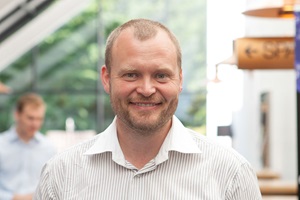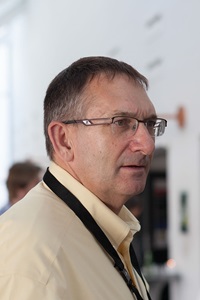This years’ version of CERE’s prime event set a new record in industry participation. While thermodynamics and reservoir engineering remained in high focus, presentations within geology and geophysics also spurred vivid discussions.
With 24 companies represented, the 2013 version of CERE’s Discussion Meeting set a new record in industry participation. The annual event is where the centre’s industrial Consortium joins CERE researchers to share experiences and exchange ideas.
 Thermodynamic modelling and reservoir engineering was mentioned by most industry participants as their prime focus point. As always lengthy sessions during the three-day event were devoted to presentations on the latest developments in these fields.
Thermodynamic modelling and reservoir engineering was mentioned by most industry participants as their prime focus point. As always lengthy sessions during the three-day event were devoted to presentations on the latest developments in these fields.
For some years now, academic resources within geology and geophysics have been present in the CERE faculty. Led by Professors Ida Fabricius (geology) and Klaus Mosegaard (geophysics) these two sections contributed strongly to the 2013 event.
As a consequence of the broadened scope of CERE, the format was modified, introducing two half-days with parallel sessions rather than keeping the entire agenda in plenum. The parallel sessions were on Thermodynamics; Enhanced Oil Recovery; Complex Fluid Systems; Geology/Geophysics.

Shale gas introduces new complexity
No least due to the general focus in the energy sector on shale gas and other unconventional energy resources, the stronger-than-usual focus on geology and geophysics was welcomed by several industry participants.
”Especially, when we talk about unconventional sources like shale gas and oil it makes sense to integrate more disciplines,” says Dr. Jose Torres of ConocoPhilips.
“As you know, we have a strong focus on unconventional sources in the US. The potential is indeed very large. But at the same time we do not understand the natural systems involved well. It is difficult to establish the boundaries; many things seem to happen at the same time. It is not always clear if you can isolate one phenomenon from the other.”
Beside the topics on the agenda Dr. Torres was also pleased by the form of the meeting:
“What I like about CERE is that the researchers take time to try to understand the problems of the industry instead of just working on their own projects.” Read more

An illustrative joke
Especially a presentation by Professor Klaus Mosegaard, CERE, triggered Dr. Harm Jan Wubs of GDF SUEZ Exploration & Production Germany.
“Professor Mosegaard told us, that when people asked him what would be the probability of oil being present in a given geological field, he would reply “Well, what probability do you want?”. His point is that if you just make your grid wide enough, the probability of oil being present will be close to 100 per cent. But that is not helpful information, as you will not really have come closer to actually finding the oil,” Harm Jan Wubs smiles.
“The joke illustrates quite well what brings me here. We do simulations every day, but we should always remember that our results are based not on nature itself, but on models. For instance we are often faced with scaling issues. Experiments are done in the lab, and we assume that you can apply the results at much larger scale, but this may not be reality. By attending here I have the chance to learn which fundamental problems are inherent in the various models. This tells me when and where we should be careful.” Read more

The uncertainty / resolution tradeoff
The presentation by Klaus Mosegaard addressed fundamental challenges in analysis of geodata, including the tradeoff between uncertainty and resolution in the solution of inverse problems. The problem is poorly understood in current practice, often resulting in biased model predictions. A project addressing the issue is sponsored by DONG Energy and Lloyds Register ODS.
“Having to deal with uncertainties is an inherent condition throughout energy engineering. One of the areas in which we are keen to implement new findings is within CO2 storage,” says Dr. Kenny Krogh Nielsen of Lloyds Register ODS.
“Currently the low price of CO2 permits halts the general progress in CO2 capture, but we are confident that the issue will continue to be in focus, and we also have clients in the field. We are convinced that better understanding of advanced thermo dynamics is needed in order to establish full scale CO2 capture and storage.” Read more

Happy to establish a direct relation
Dr. Hussein Alboudwarej of Chevron was originally trained in chemical engineering and has moved into reservoir simulation during his career at Chevron. He attends the Discussion Meeting for the first time:
“I find the focus of the event quite wide. Equations of state for aquifers, electrolytes, CPA, PC-SAFT etc. are covered beside the more traditional thermo dynamic simulations. Although not directly relevant to my work, it is nice to be introduced to these more advanced models.”
Dr. Alboudwarej sees his participation as “exploration”:
“I have followed the work led by Professors Erling Stenby and Michael Michelsen from a distance over quite some time. I am glad to have the opportunity to establish a direct relation. Also, I am always interested in obtaining relevant experimental data. Thus the visits to CERE’s laboratories are probably my favorite items on the agenda.” Read more

“Our business is complicated”
Benjamin Sargent of Maersk Oil finds the scientific scope of the Discussion Meeting “quite broad” – which he likes:
“You have topics covered which focus on virtually every part of our business. The thermodynamic section is particularly interesting to us, but I also welcome that CERE has taken up new areas within the geo-disciplines. I find this natural.”
The integration of several disciplines reflects the needs of the industry, Benjamin Sargent feels:
“Our business is very complicated. Reservoirs are becoming harder to find and develop, leading to ever more complex challenges for exploration and production engineers to solve. And at the same time our products are commodities for which prices fluctuate up and down, leading to changes in the framework conditions for our research and development. All these factors point to a need for integrating several disciplines. At Maersk Oil we already have organized our work within reservoir engineering, geology, and geophysics as one single team.” Read more
Joy and melancholy
Dr. Klaus Potsch of Austrian based oil corporation OMV notes with satisfaction that presentations within geology and geophysics take up a larger proportion of the event compared with previous years:
take up a larger proportion of the event compared with previous years:
“I see CERE’s expansion into geology and geophysics as natural. Oil and gas exploration is progressing into ever more complex geology and it will be necessary to include the geological features better to achieve accurate reservoir simulations.”
To Klaus Potsch the 2013 version of CERE’s Discussion Meeting marks a mixture of joy and melancholy:
“I have attended the meeting for many consecutive years, but this will be my last event, as I will have retired before next years’ meeting,” he says, summing up his experience with attending over the years:
“I have always had the feeling that I could present problems to the CERE faculty and know that they would actually take time to think about what the solution might be. Networking is obviously a large part of it. I have enjoyed coming here, not just for the science but also on a personal level. I have made many friends over the years.” Read more
The CERE Discussion Meeting 2013 was held from June 19th – June 21th 2013 at Comwell Borupgaard, Snekkersten. 36 industry participants representing 24 companies and 12 nationalities attended.